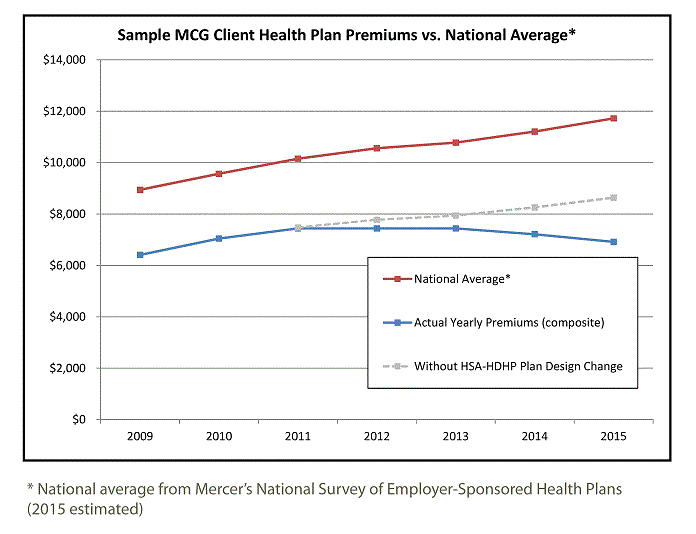HSA-HDHPs as a Health Care Cost Control Strategy
August 12th, 2015 - Marsh Consulting Group
In the battle to control health care costs, one of an employerfs weapons is the Consumer Driven Health Plan (CDHP) or High-Deductible Health Plan (HDHP). High-deductible plans were created in the 1990s as a way for employers to control premium costs by shifting some health care responsibility to employees. Congress added firepower to HDHPs through legislation that created Health Savings Accounts (HSAs) in 2004. These employee-owned accounts allowed pre-tax contributions to fund an employeefs outof- pocket costs. In 2010, the Affordable Care Act added the requirement that all health plans, including HSA-HDHPs, include preventive care at no additional cost to the individual.
The combination HSA-HDHP increased in popularity in response to the double-digit health care cost increases in the 2000s. Employees liked that HSAs allowed them to invest their savings from paying lower premiums toward health care costs in the future, or even retirement costs. Employers liked that the HDHP component encouraged employees to think about the costs of doctor visits and medicines. The recent availability of price comparison tools now enables employees to comparison shop among providers, and can lead to further savings for both employees and employers.
The number of employers offering HSAHDHPs continues to grow. While about half of large employers offered an HDHP in 2009, nearly three out of four did so in 2014.1 In addition to saving on health care costs, HSAHDHPs may help employers avoid triggering the so-called gCadillac Tax.h The Cadillac Tax, set to go into effect in 2018, levies a 40% excise tax on health plans that cost more than $10,200 per year for individual coverage and $27,500 for family coverage. Health plan cost is defined as the total premiums paid by both the employee and the employer, so by lowering premiums via an HSA-HDHP the health plan cost is able to dip below the tax thresholds.
While employers typically offer an HSA-HDHP alongside traditional health plans, this does not tend to produce significant costs savings because the healthier employees—who have lower health costs—are the ones who choose the HSA-HDHP. As a result, the employerfs health plan loses revenue from lower premiums paid by employees who choose the HSA-HDHP without seeing a significant drop in its expenses. To achieve significant savings, an employer may need to completely replace its health plan options with an HSA-HDHP.
MCG has led several of its clients through a full-replacement HSAHDHP in recent years. Employees may adapt to the change more easily if it is phased in over several years. For example, an employer can first introduce the HSA-HDHP alongside other options, then increase the employeefs cost for traditional plans, and finally offer the HSA-HDHP as the only choice. To make the switch more palatable, some employers like to pre-fund their employeesf Health Savings Accounts (HSAs) to help pay for some health costs before the deductible. While this is popular with employees, pre-tax HSA contributions—by either the employer or the employee—will be counted toward the Cadillac Tax thresholds as part of the health plan gcost.h It is important to remind employees that the HSA contributions are not gfree money,h but rather part of the total compensation package that includes salary, retirement, and other employee benefits.
Several of MCGfs clients have fully replaced their health plans with an HSA-HDHP in recent years, resulting in a significant reduction in health care costs. One mid-size employer, covering about 2,800 employees and dependents, has seen a decrease in its health care costs since replacing its low-deductible PPO plan with a high-deductible, HSA-compatible plan in 2011.
As a result, its total annual premiums, which includes both employer and employee contributions, are nearly $5,000 per year lower than the national average for employer plans. This level of savings is not unheard of—HSA-compatible health plans typically cost 20% less than a low-deductible PPO or HMO plan.2
In order to achieve that high level of savings without a decrease in care, MCG assists its clients with a comprehensive communications strategy to educate employees about how to open and operate an HSA, what tools are available to compare costs, and which preventive services are covered under the plan. One of the criticisms about HDHPs is that these plans simply shift costs from employers to workers, and favor wealthy and healthy participants at the expense of those with lower incomes and poorer health. Over the years there have been numerous studies comparing preventive care use between HDHPs and traditional health plans. While some studies (many conducted before ACAfs preventive care requirement) show a decrease in preventive care and screenings in the first few years, this reduction tends to disappear with time. One of the more recent studies of 13 million employees and dependents covered under HDHPs found that cost savings lasted throughout the three-year study. While the study was unable to directly assess preventive care use, it noted that there was not a spike in emergency-room visits or hospital admissions due to forgone care. Costs savings resulted from reduced spending on pharmaceuticals, doctor visits, and other outpatient care.3
In the end, HSA-HDHPs should have the same goal as any employer health plan: to support both employee health and the businessfs bottom line. To accomplish this goal requires a strategic approach to the cost drivers of the health plan, management of the plan, regulatory compliance, and a comprehensive communications campaign to educate and engage employees in their health choices. When this is done successfully in an HSA-HDHP, employees make more cost-effective, informed decisions that can lead to $2,000 or more in annual health cost savings.4
1 Towers Watson/National Business Group on Health (2014). gAnnual Employer
Health Care Survey.h http://www.towerswatson.com/DownloadMedia.
aspx?media={B5CC3143-9B78-4B92-96A4-3F569300406F}
2
Bilski, Jared (2015, April). g7 cost-cutters youfll need to fight emerging
healthcare trends.h http://www.hrbenefitsalert.com/7-cost-cutters-youll-need-to-fightemerging-
healthcare-trends/
3 National Bureau of Economic Research
(July 2015). gDo eConsumer-Directedf Health Plans Bend the Cost Curve Over
Time?h (NBER Working Paper No. 21031)
http://www.nber.org/digest/jul15/w21031.html
4 Marsh
& McLennan (July 2015). gBenefit Advisor.h http://mcgrawwentworth.com/wp-content/uploads/BA_Issue_V18_4.pdf
